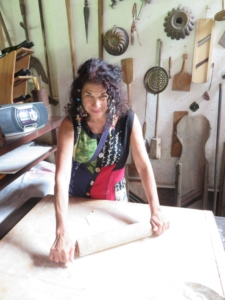
Rolling out strudel dough at Dunaalmási Lovarda, a Hungarian family farm and cooking school.
“Just take one bite. If you don’t like it, you don’t have to eat a second.” I can still hear my mom’s cajoling words when I turned up my nose or clenched my mouth tight. Light years later, those very words slipped out of my mouth when my picky-eater daughter would refuse to eat what I had cooked. Fortunately for both of us, now world class champions of trying a bite of something unfamiliar (no insects, please… I can only bend so far!), the “try one bite rule” has enabled us to travel across many countries and continents, devouring many new foods along the way.
When my even-pickier husband, Russ, and I travel, his priorities are historic architecture and wine. Mine begin with food. I want to try dishes the locals eat. I will order the same meal at different restaurants just to see how each (always labeled authentic) is prepared. I thoroughly enjoy taking cooking classes when we travel. I’ve made strudel and goulash in Hungary, pasta in Italy and candied pumpkin dessert in Mexico. Some people shop for clothes, souvenirs, and jewelry when they travel. I purchase locally produced spices, oils and mustards.
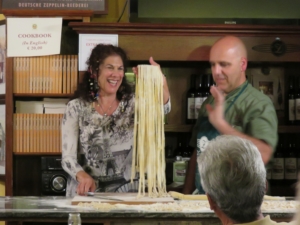
Chef Lorenzo Polage taught us the fine skills of pasta making at Zeppelin Restaurant & Cooking School in Orvieto, Italy.
Those moments when the first bite has crossed my lips, or when I watch a chef teach a technique, become photographically etched into my sensory memory. Ask me about a place and I might remember a particular meal before remembering buildings and art at which I had gaped in wonder.
Some people eat to live. I laughingly jest that I live (and therefore, exercise) to eat.
I’ve never understood why people will travel and then only want to eat the food from home. I recall a particular trip when I chaperoned my daughter Gabrielle and her high school choir to England, where they were to perform. Other chaperones were taking their groups to requested American burger and pizza chains. I told my group, which was supposed to only be four students, that we’d eat none of that. We were going to try a variety of ethnic foods popular in those neighborhoods only. Unsure if I’d be left with just my daughter, I was taken aback when my group expanded to nine. Not one student backed away from experiencing foods we saw the locals eating from packed restaurants. It gave new meaning to “put your money where your mouth is.”
I grew up as a second generation American with European roots. My grandparents were Polish, Romanian, Hungarian and Austrian, with every female an amazing cook and/or baker. My dad was military, so we moved frequently across the United States as well as to France and Germany. I grew up making my Aunt Fanny’s stuffed cabbage, my grandma’s chicken matzah ball soup, and my Aunt Golda’s almond rugelach (a crescent-shaped cookie filled with raisins, nuts and dried fruits). I learned to make an apple tart with pie crust at five and learned how to roll out thinly pliable strudel dough. (Nowadays I simplify with filo or puffed pastry.)
My mom’s family was still depression-era poor when we’d have long stays with them during my Air Force dad’s tours of duty. I can vividly recall standing by the Coney Island apartment front stoop inhaling rich aromas filtering from the ethnically diverse neighboring apartments. My cooking education began with watching and participating in my family’s meals, understanding that we never knew who (and how many) might pop in for a meal, and G-d forbid anyone left hungry, so knowing how to stretch whatever ingredients were available was responsibly crucial and a lesson to which I still adhere today (though my husband insists I cook for an army when we have even two guests).
My Mom was an extraordinary cook and baker, skills she enhanced each time we moved. Culturally curious and socially friendly, she believed we should eat and cook the traditional foods of our environment. Neighbors of our French countryside farm who had barely survived World War II’s famine taught her to make stone soup. While briefly stationed In Garmisch, Germany, a local chef schooled her in sauerbraten and bacon Kartoffelkloesse (potato ball dumplings). Egg-topped enchiladas and taco meat cooked slowly in a pot became family favorites, thanks to Donna Navarrete, a military wife who cooked her Mexican husband’s family recipes and became my mom’s dearest friend. When I was married to Janos, a Hungarian refugee who had boldly escaped Communism in pursuit of freedom (only to die at much-too early an age), I learned to make chicken paprikash and stuffed cabbage Hungarian-style (quite different from Aunt Fanny’s Romanian version).
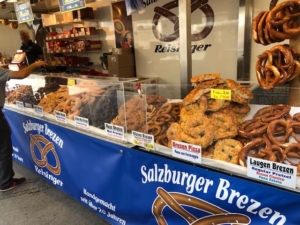
Soft pretzel bagels (as we called them in New York) are sold everywhere in Poland.
I rarely fix most of these meals now. Many are meat-heavy, rich in calories, or just don’t jive with guests’ dietary restrictions, such as needing to be gluten or dairy free. My mom and my female ancestors are with me in spirit when I travel with Russ. When I visit New York, I want “real” bagels, seeded rye, hot pretzel bagels we’d off carts, and a slice of thin pizza. (My local grocery carries real frozen bialys and knishes, so I am not totally lacking in some of my favorite Brooklyn foods.)
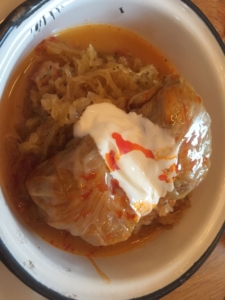
Hungarian stuffed cabbage topped with sauerkraut and sour cream is a traditional dish.
When Russ and I visited Poland, I obsessed over perogies and in Hungary, I ate sauerkraut-topped stuffed cabbage as often as possible. On that Eastern Europe trip with Odysseys Unlimited (https://karenkuzsel.com/2018/09/27/part-7-eastern-europe-strudel-schnitzel-and-strauss-a-few-of-our-favorite-things/), we had a strudel and Hungarian goulash cooking class at Dunaalmási Lovarda, a family farm and cooking school. In Avignon, France, even Russ joined in preparing the multi-course meal at La Mirande, a five-star boutique hotel with cooking school and wine tasting cellar. Do you even need to ask how much wine we first tasted in the cellar and then drank during dinner? (https://karenkuzsel.com/2019/08/02/part-3-southern-french-connection-art-food-and-wine/) High on the Italian mountaintop medieval city of Orvieto, Chef Lorenzo Polage allowed me to slice fresh pasta at his Zeppelin Restaurant & Cooking School that resides in a 200-year-old building reminiscent of a stone-age rock cave. (https://karenkuzsel.com/2018/06/19/part-4-gondaliers-dont-sing-and-no-italian-wedding-soup-a-first-timers-discovery-of-the-real-italy/)
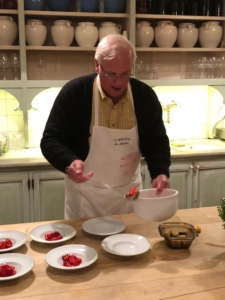
Russ cooking at La Mirande boutique hotel, restaurant and cooking school n Avignon, France.
As a travel journalist, I have been blessed to cook in out-of-the-way wineries, specialty farms, and hotel kitchens. One of my favorites was to the 17-acre Huerta Los Tamarindos organic farm/restaurant and cooking school in San José Del Cabo, Mexico. We picked the herbs. We toured the fields and venue spaces before settling into the rustic kitchen that could easily accommodate 18 for a class. In a two-hour stretch, I minced herbs, stirred pots, and picked up some fascinating cooking tips, such as roasting black peppercorns and then smashing them will add a smoky flavor to food. We marinated five different types of eggplants that we roasted and dipped into a spicy oil we’d prepared, an arugula and mango salad, a mahi al achiote and green rice entrée, and dessert of boiled and sweetened fresh pumpkin called dulce de calabaza. We toasted the meal and our (haha) intense labors with the tea and tamarind margaritas rimmed in chili pepper. (Los Cabos: A Mexican Fiesta Of Food, Fun And Unique Experiences)
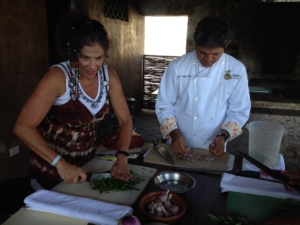
Dicing herbs at Huerta Los Tamarindos organic farm/restaurant and cooking school in San José Del Cabo, Mexico.
Food is love. It stirs my nostalgia of family and sharing meals. It stokes my imagination about what do I have available to create a meal, even last minute? It fires up my desire to taste more, cook more. Food isn’t why I travel, but it does spark my attention for what titillating delights my tongue will savor next. The pandemic hasn’t stopped me from stretching my culinary creativity (much to Russ’ regret that I don’t stick to his preferred meat & potatoes upbringing), though I miss entertaining groups of friends. Most of all, I want to once again travel and experience all the flavors, ingredients, and aromas unique to that time, that place.
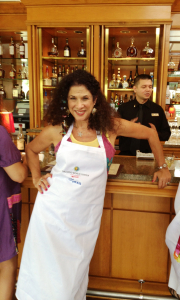
On a press assignment at Marriott World Trade Center Orlando I got to cook, eat and take home an apron with my name embroidered.
Karen Kuzsel is a writer-editor based in the Orlando area who specializes in the hospitality, entertainment, meetings & events industries. She is an active member of International Live Events Association and Meeting Professionals International and is now serving on the 2021-2022 MPI Global Advisory Board for Independent and Small Business Owners. She is a member of the Society of Professional Journalists. Karen writes about food & wine, spas, destinations, venues, meetings & events. A career journalist, she has owned magazines, written for newspapers, trade publications, radio and TV. As her alter-ego, Natasha, The Psychic Lady, she is a featured entertainer for corporate and social events. Karen@KarenKuzsel.com; www.KarenKuzsel.com; www.ThePsychicLady.com; @karenkuzsel; @thepsychiclady. Food photos for this series by Karen Kuzsel. All other Photos by Russ Wagner, a retired government planner/builder who has a passion for historic architecture, wine, trains, travel and taking photographs.
